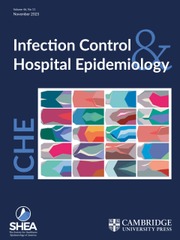Crossref Citations
This article has been cited by the following publications. This list is generated based on data provided by
Crossref.
Livermore, D. M.
2009.
Has the era of untreatable infections arrived?.
Journal of Antimicrobial Chemotherapy,
Vol. 64,
Issue. Supplement 1,
p.
i29.
Woodhouse, Douglas
Berg, Marc
van der Putten, Joris
and
Houtepen, Judith
2009.
Will benchmarking ICUs improve outcome?.
Current Opinion in Critical Care,
Vol. 15,
Issue. 5,
p.
450.
2009.
ICS Medal Winners and Research Abstract Presentations.
Journal of the Intensive Care Society,
Vol. 10,
Issue. 1,
p.
52.
Creamer, Eilish
Dolan, Anthony
Sherlock, Orla
Thomas, Toney
Walsh, John
Moore, Joan
Smyth, Edmond
O'Neill, Eoghan
Shore, Anna
Sullivan, Derek
Rossney, Angela S.
Cunney, Robert
Coleman, David
and
Humphreys, Hilary
2010.
The Effect of Rapid Screening for Methicillin-ResistantStaphylococcus aureus(MRSA) on the Identification and Earlier Isolation of MRSA-Positive Patients.
Infection Control & Hospital Epidemiology,
Vol. 31,
Issue. 4,
p.
374.
Baker, Stacey E.
Brecher, Stephen M.
Robillard, Ernest
Strymish, Judith
Lawler, Elizabeth
and
Gupta, Kalpana
2010.
Extranasal Methicillin-Resistant Staphylococcus aureus Colonization at Admission to an Acute Care Veterans Affairs Hospital.
Infection Control & Hospital Epidemiology,
Vol. 31,
Issue. 1,
p.
42.
Glasgow, Justin M.
Scott-Caziewell, Jill R.
and
Kaboli, Peter J.
2010.
Guiding Inpatient Quality Improvement: A Systematic Review of Lean and Six Sigma.
The Joint Commission Journal on Quality and Patient Safety,
Vol. 36,
Issue. 12,
p.
533.
Burkitt, Kelly H.
Sinkowitz-Cochran, Ronda L.
Obrosky, D. Scott
Cuerdon, Timothy
Miller, LaToya J.
Jain, Rajiv
Jernigan, John A.
and
Fine, Michael J.
2010.
Survey of employee knowledge and attitudes before and after a multicenter Veterans' Administration quality improvement initiative to reduce nosocomial methicillin-resistant Staphylococcus aureus infections.
American Journal of Infection Control,
Vol. 38,
Issue. 4,
p.
274.
Anderson, Judith
Gosbee, Laura Lin
Bessesen, Mary
and
Williams, Linda
2010.
Using human factors engineering to improve the effectiveness of infection prevention and control.
Critical Care Medicine,
Vol. 38,
Issue. ,
p.
S269.
Nelson, R.E.
Samore, M.H.
Smith, K.J.
Harbarth, S.
and
Rubin, M.A.
2010.
Cost-effectiveness of adding decolonization to a surveillance strategy of screening and isolation for methicillin-resistant Staphylococcus aureus carriers.
Clinical Microbiology and Infection,
Vol. 16,
Issue. 12,
p.
1740.
Garcia-Williams, Amanda G.
Miller, LaToya J.
Burkitt, Kelly H.
Cuerdon, Timothy
Jain, Rajiv
Fine, Michael J.
Jernigan, John A.
and
Sinkowitz-Cochran, Ronda L.
2010.
Beyond ß: Lessons Learned from Implementation of the Department of Veterans Affairs Methicillin-Resistant Staphylococcus aureus Prevention Initiative.
Infection Control & Hospital Epidemiology,
Vol. 31,
Issue. 7,
p.
763.
Sroka, S.
Gastmeier, P.
and
Meyer, E.
2010.
Impact of alcohol hand-rub use on meticillin-resistant Staphylococcus aureus: an analysis of the literature.
Journal of Hospital Infection,
Vol. 74,
Issue. 3,
p.
204.
Pofahl, Walter E.
Ramsey, Keith M.
Nobles, Delores L.
Cochran, M. Kathy
and
Goettler, Claudia
2011.
Importance of Methicillin-Resistant Staphylococcus aureus Eradication in Carriers to Prevent Postoperative Methicillin-Resistant Staphylococcus aureus Surgical Site Infection.
The American Surgeon™,
Vol. 77,
Issue. 1,
p.
27.
Kim, Jong Hun
Toy, Diana
and
Muder, Robert R.
2011.
Clostridium difficileInfection in a Long-Term Care Facility: Hospital-Associated Illness Compared with Long-Term Care-Associated Illness.
Infection Control & Hospital Epidemiology,
Vol. 32,
Issue. 7,
p.
656.
Backman, Chantal
Taylor, Geoffrey
Sales, Anne
and
Marck, Patricia Beryl
2011.
An integrative review of infection prevention and control programs for multidrug-resistant organisms in acute care hospitals: A socio-ecological perspective.
American Journal of Infection Control,
Vol. 39,
Issue. 5,
p.
368.
Ellingson, Katherine
Muder, Robert R.
Jain, Rajiv
Kleinbaum, David
Feng, Pei-Jean I.
Cunningham, Candace
Squier, Cheryl
Lloyd, Jon
Edwards, Jonathan
Gebski, Val
and
Jernigan, John
2011.
Sustained Reduction in the Clinical Incidence of Methicillin-Resistant Staphylococcus aureus Colonization or Infection Associated with a Multifaceted Infection Control Intervention.
Infection Control & Hospital Epidemiology,
Vol. 32,
Issue. 1,
p.
1.
Zimmerman, Peta-Anne P.
Yeatman, Heather
and
Jones, Michael
2011.
Frameworks to assist adoption of infection prevention and control programs. Does the literature exist?.
Healthcare infection,
Vol. 16,
Issue. 4,
p.
129.
Jain, Rajiv
Kralovic, Stephen M.
Evans, Martin E.
Ambrose, Meredith
Simbartl, Loretta A.
Obrosky, D. Scott
Render, Marta L.
Freyberg, Ron W.
Jernigan, John A.
Muder, Robert R.
Miller, LaToya J.
and
Roselle, Gary A.
2011.
Veterans Affairs Initiative to Prevent Methicillin-ResistantStaphylococcus aureusInfections.
New England Journal of Medicine,
Vol. 364,
Issue. 15,
p.
1419.
Jarvis, William R.
Jarvis, Ashley A.
and
Chinn, Raymond Y.
2012.
National prevalence of methicillin-resistant Staphylococcus aureus in inpatients at United States health care facilities, 2010.
American Journal of Infection Control,
Vol. 40,
Issue. 3,
p.
194.
Nicolay, C R
Purkayastha, S
Greenhalgh, A
Benn, J
Chaturvedi, S
Phillips, N
and
Darzi, A
2012.
Systematic review of the application of quality improvement methodologies from the manufacturing industry to surgical healthcare.
Journal of British Surgery,
Vol. 99,
Issue. 3,
p.
324.
Stenehjem, Edward
Rimland, David
Crispell, Emily K.
Stafford, Cortney
Gaynes, Robert
and
Satola, Sarah W.
2012.
Cepheid Xpert MRSA Cycle Threshold in Discordant Colonization Results and as a Quantitative Measure of Nasal Colonization Burden.
Journal of Clinical Microbiology,
Vol. 50,
Issue. 6,
p.
2079.

